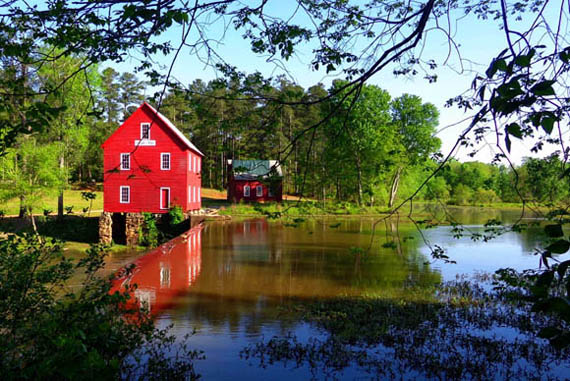We're back! This is at least our sixth time camping at McDowell Mountain
since 2004 and
we have reservations again for two weeks in January.
Even though we try to visit some new places each RV trip, this is one
of our favorites places to hang out for a few days or weeks in the
winter. We haven't been here since December of 2010. After eight years
it feels sort of new to us, and and yet familiar at the same time. Does
that make sense?
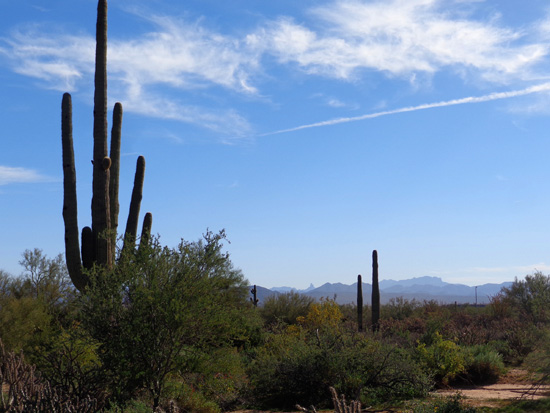
Old and younger saguaro cacti on the North Trail
(12-24-18)
The campground and most trails are the same as when we were here
previously but there are some new trails for us to explore and some new features
along the way.
I didn't have time in just a few days this week to hike
any of the new trails but I'll check them out in January when we'll
be here longer. We arrived this past Sunday morning and will
leave tomorrow (Thursday) morning.
It was a short 39-mile drive
from our campsite at Lost Dutchman to this site:
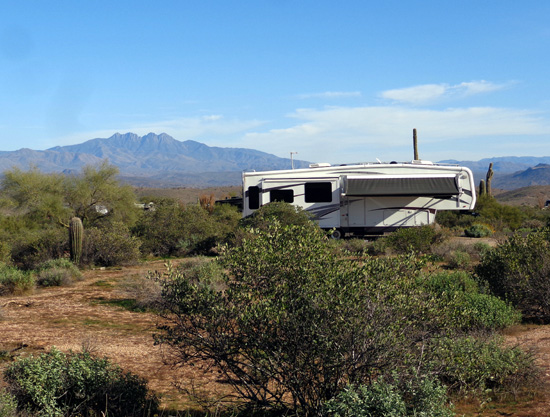
Our Cameo, with Arizona's iconic
Four Peaks in the distance (12-23-18)
The two loops in McDowell Mountain's E.I. Rowland Family Campground
have a total of 76 developed RV sites with water and 50-amp electricity.
A dump station is located at the entrance to the loops.
There are also some group campgrounds without hookups located in
other areas of the park.
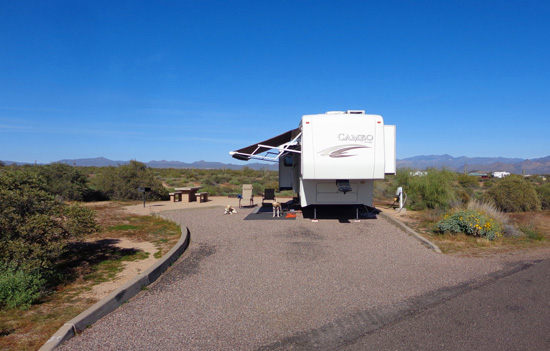
We reserved our favorite site in the park for both
visits this winter but it wasn't easy.
Most sites in our campground are back-ins; about a quarter of them
are pull-thrus. We reserved this specific back-in site at the high end
of one loop six months ago
because we've occupied it before and liked its privacy. It has plenty of room for
the Cameo and truck, and awesome views of the surrounding mountains and desert.
One of my favorite views is toward the south where we can see
Weaver's Needle:

Weaver's Needle is the pointy
peak in the distance, just to the right of our camper.
(12-23-18)
We were closer to Weaver's Needle at
Lost Dutchman but couldn't see it from within the park.
We
paid for our site when we made reservations six months ago. The fee is
currently $32/night for 50-amp electricity and water. There is a
two-week limit and no weekly rates.
Sites are on pea gravel and include a grill, fire ring, and picnic
table. It's easy to walk the dogs next to and behind our camper, as long
as we watch for cholla and other cacti stickers on the ground. Those can
be very painful if a dog steps on one.
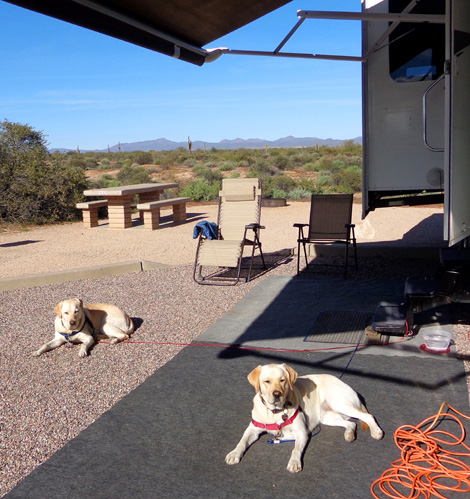
Casey (L) and Holly enjoy some winter Arizona
sunshine (12-23-18)
Watch especially for little Teddy Bear Cholla AKA Jumping Chollas;
their little balls of barbed needles that "jump off" hurt like
crazy for both you
and your dog if you try to remove them with your fingers. They are
lightweight so the wind can easily blow them onto trails and paved
areas.
You can see
some of the little pieces that have "jumped off" and are lying on the
ground next to the cholla in the next picture:

Although we are farther from civilization now than we were at Lost
Dutchman, our Verizon phone and internet signals are better here. Yay!
What's really weird is that the only TV stations we get with our camper
antenna are from Tucson, not metro Phoenix -- which is considerably
closer. We don't have satellite service.
SUNRISE, SUNSET
This park is one of the best places we've ever visited for
spectacular sunrises and sunsets. It's surrounded by mountains in every
direction and from our site we have some fabulous views:
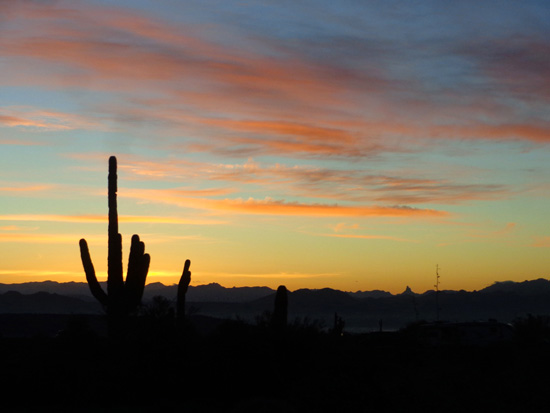
Sunrise over the Superstitions
(12-27-18)
Only problem for me was getting up early enough to see the Four Peaks
Wilderness to the east and Superstition Mountains (with Weaver's Needle)
at sunrise, and to get out while I was preparing supper between 5-6 PM to
capture the even more panoramic sunsets.
Here are a couple more shots from this visit; I'll have more (and
better ones) from our January, 2019 visit when we will be here longer.
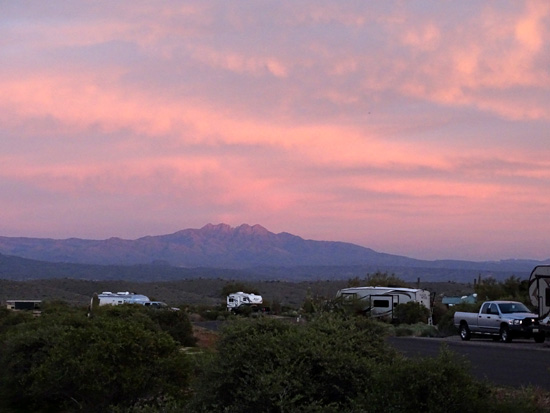
Bright pink sunset over Four Peaks
(12-25-18)

Sunset over the McDowell
Mountains (12-23-18)
TRAIL SCENES
One of the biggest draws for us at McDowell Mountain Park is the
extensive multi-use trail system.
With the addition of some new trails, there are probably now more
than 50 miles of unpaved trails in the park, ranging in distance from less than
half a mile to more than 15 miles. Runners, cyclists, and horse riders
can go much farther than that if they combine various trails. There are
also about ten miles of paved roads in the park.
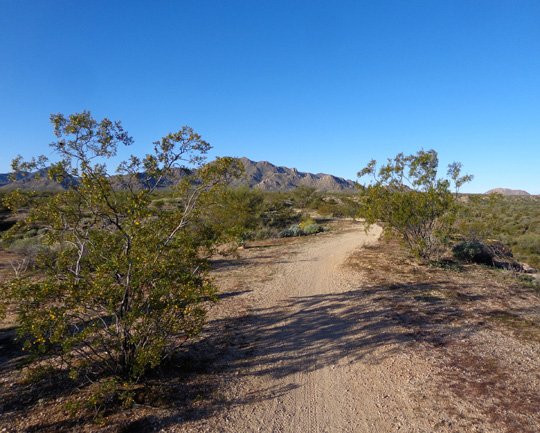
The smooth, undulating Bluff
Trail runs north from near the campground so it's used a lot by
runners, hikers, cyclists, and
equestrians. Note the two large creosote bushes in bloom.
(12-24-18)
The first time we visited the park was in February, 2004, when I ran
the Pemberton 50K ultra marathon on the popular Pemberton Trail that
encircles the park. Another running event that sells out quickly is the
Javelina Jundred 100-mile race in October; we've never done that
particular 100-miler.
It appears that mountain bikers have pretty much taken over the
trails where they are allowed, which is most of the trails in this
park. Although they have their own separate "competitive track" with
trails of varying difficulty close to the park entrance, they also use
the rest of the trails in the park.
Hikers, especially those with children or dogs, need to be very
careful on all the trails, so they don't get run over. Most cyclists are
courteous and relatively careful but some just come whizzing down hills
or around blind curves like they are the only ones out there.
Don't they ever run into each other??
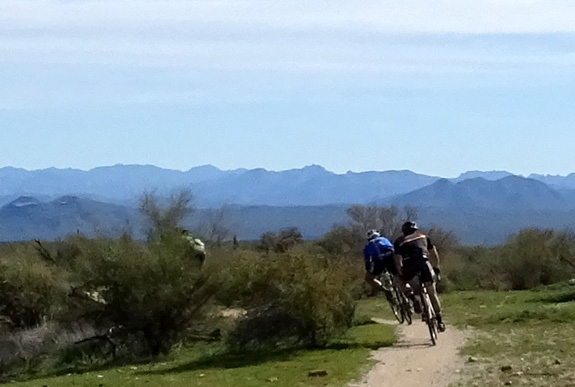
Our biggest regret this trip is that we didn't bring our bikes. We
don't ride fast or on gnarly trails but we could do fine on some of
McDowell's trails.
There is a wide variance not only in trail distances but also trail
difficulty and surfaces. Some trails like the North Trail (a three-mile
loop) are relatively flat and smooth. The 15+ mile long Pemberton Loop
has quite a few hills and some rocky areas.
Many of the trails have some loose sand where they cross washes,
especially the large Stoneman Wash that bisects the park:
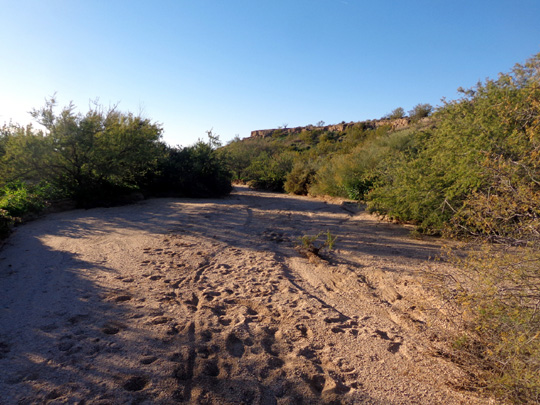
Intersection of the Bluff and
Stoneman Wash trails; several trails cross the wide wash.
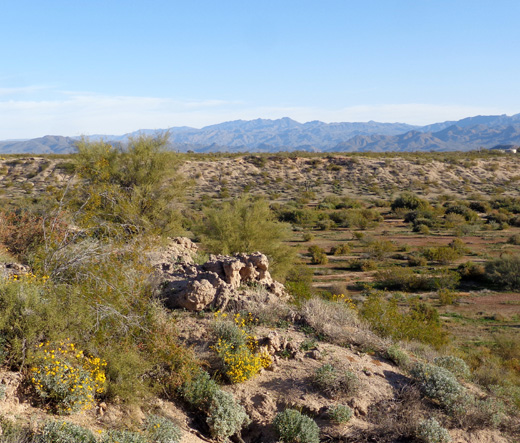
Looking down at Stoneman Wash
when the Bluff Trail really is up on the bluff
Stoneman Wash runs for 4.3 miles. Because it has
some fairly deep sand, it is used mostly by equestrians.
This week we both hiked the North Trail with the dogs, took them on
several walks around the campground on paved roads (less likely to get
cactus stickers in their paws there!), and at Fountain Park in Fountain Hills.
I've shown a few trail scenes already. Here are some more from the
North Trail:
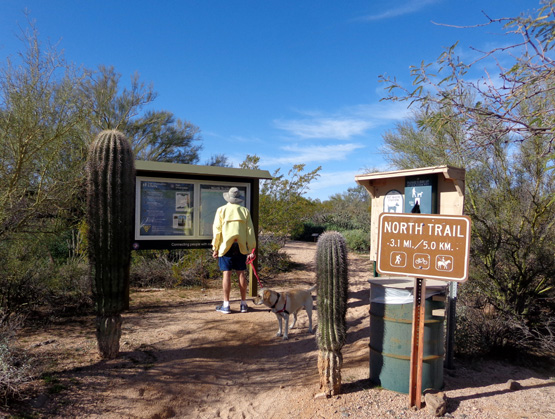
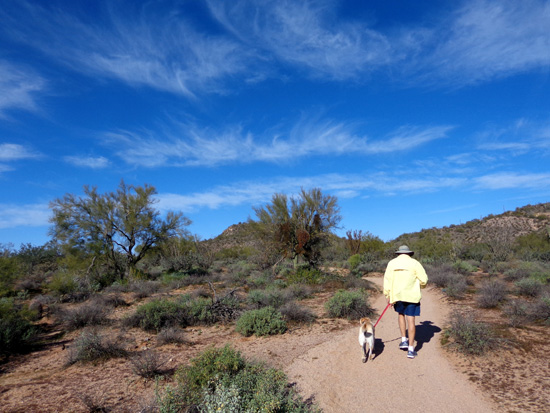
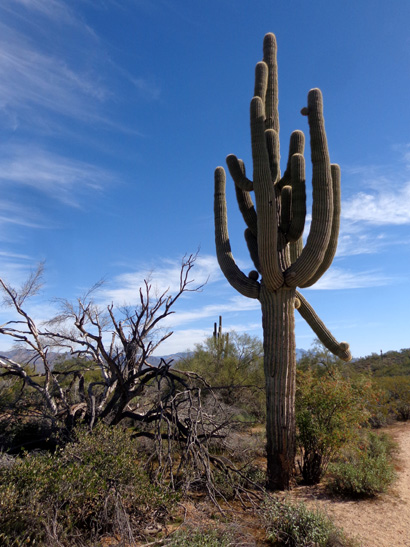
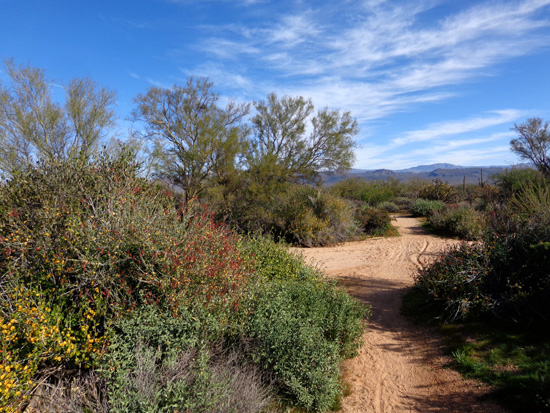
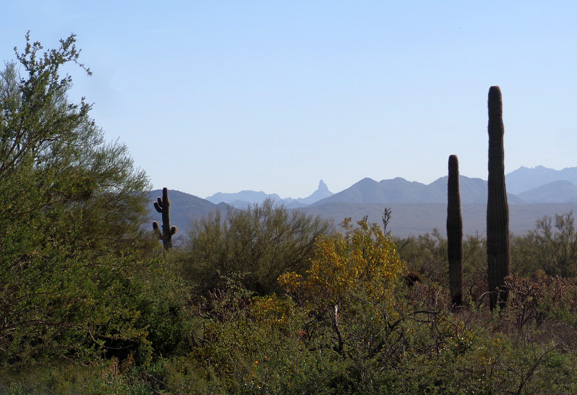
I also took Holly south on the Granite Trail near
the campground . . .


. . . and Casey on a four-mile loop north of the campground on
the Bluff and Granite Trails:
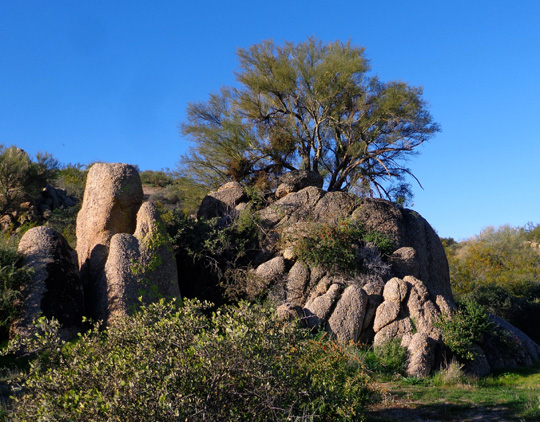
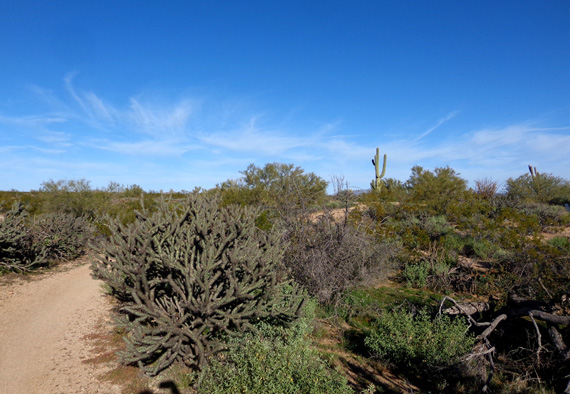
Jim's resting up for a 48-hour foot race this weekend at Across the
Years (ATY) so he didn't walk as much as I did.
PLANT LIFE
I always enjoy seeing the various kinds of cacti and wildflowers
during the winter in Arizona.
This winter has had more than the average amount of rain so the desert floor
is about as green as we've ever seen it previously.
I do remember on one other visit years ago, joking with Jim that the rangers might have
to get out some lawnmowers if the grass gets any higher! [There was even
more green grass when we returned in January.]
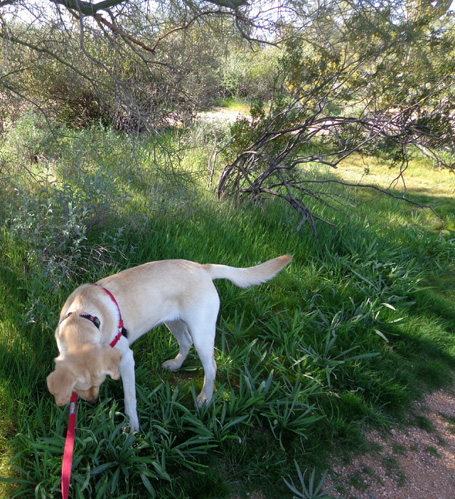
Holly sniffs in some lush "grass" under a
tree along the North Trail. (12-24-18)
More rain means not only more green grass for the critters that
live here, it also means more wildflowers are in bloom now than
in drier years -- and probably more of a proliferation of flowers
this coming spring.
While walking and driving through the park I spotted more than a
dozen different kinds of flowers this week, including bright yellow brittlebush
and creosote, gold desert poppies,
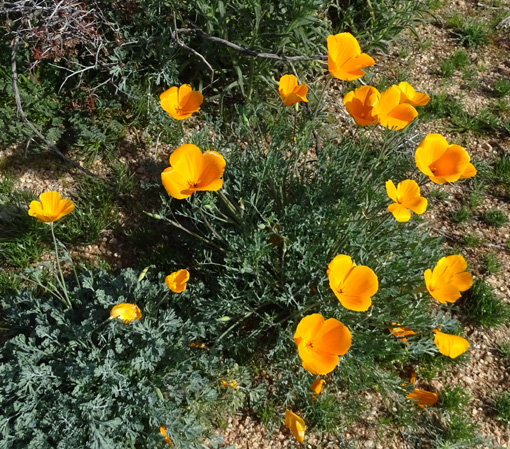
orange globe mallow,
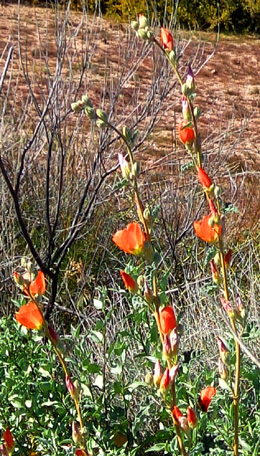
red chuparosa, pink fairy duster,
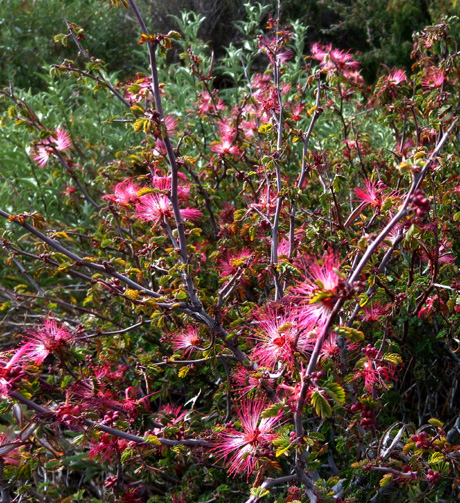
purple owl clover (a type of Indian paintbrush), blue lupines,
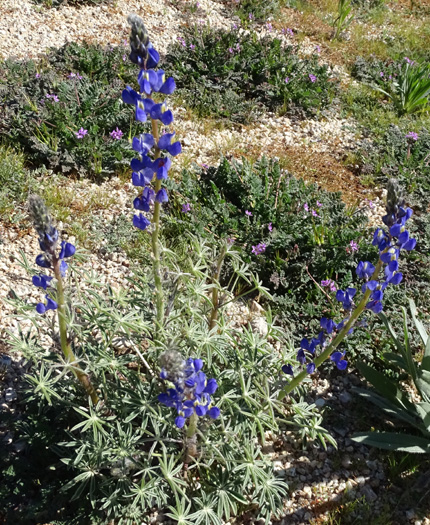
and several other kinds of yellow, white, and purple wildflowers.
I haven't seen any cacti in bloom yet -- still pretty early for that.
I was hoping to see at least one javelina AKA collared peccary but haven't yet.
I'd love to see how our dogs react to one of those odd-looking pig-like creatures
(from a distance). We've heard coyotes singing in the distance but we
haven't seen any of those up closer, either.
We have seen lots of rabbits, birds, and a couple foxes near our campsite.
THE PARK AT FOUNTAIN HILLS
The main route to McDowell Mountain Regional Park takes visitors through the
small city of Fountain Hills, which truly is hilly and does have a fountain.
In fact, this fountain is billed as the world's tallest, at least when all
three pumps are on (560 feet). Most of the time, including this week, only
two pumps are running (330 feet) but the fountain is still impressive when
it's turned on for 15 minutes at the top of each hour:
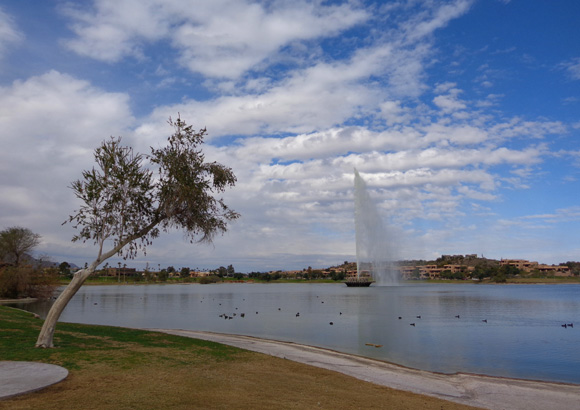
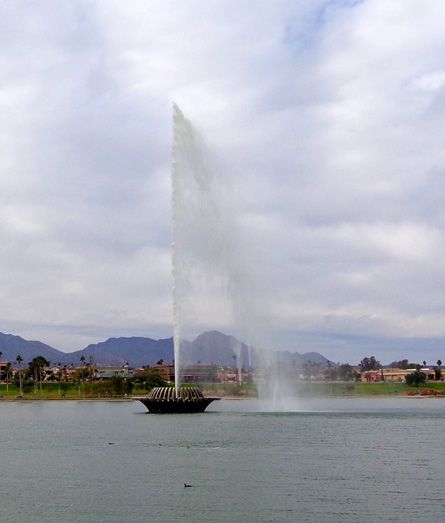
It's so tall, we can see it from many locations at McDowell Mountain
Park when it's on. That's ten miles or more as the crow flies. When I'm
hiking I often turn toward its location to see if it's on. I'm a bit
obsessed with that fountain.
We had errands to run in Fountain Hills twice this week and visited Fountain
Park twice with the dogs. It's a popular place for people to walk, even on weekdays.
We really enjoyed all the green grass (not a lot of that in Arizona), landscaping,
sculptures, and the military veterans' memorial surrounding the 33-acre lake:
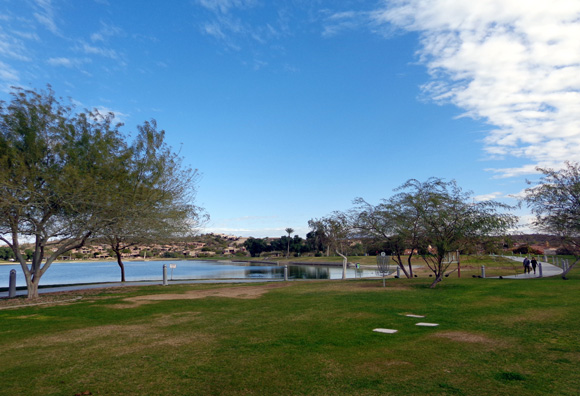
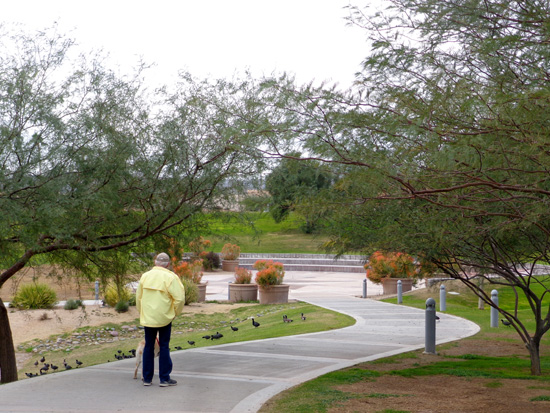
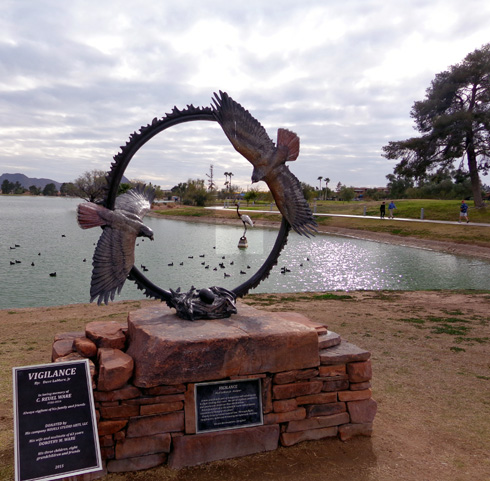
Foreground sculpture is named "Vigilance"
as two birds watch over their egg;
the sculpture I highlighted in the water is
"Big Blue," a heron.

Both Casey (above) and Holly had the same reaction
to this life-like, life-size statue of a little boy
and a handsome black Lab ("My Buddy") -- they
barked first, then slowly went closer to inspect.
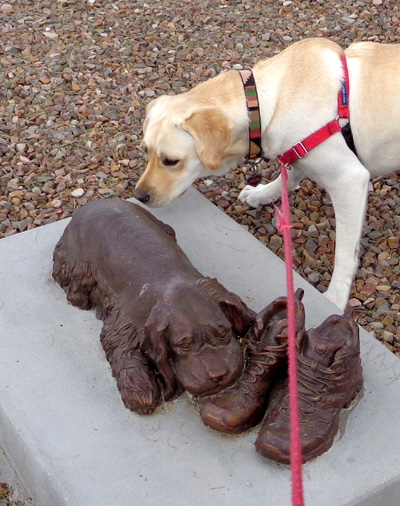
Nearby was this poignant little statue called
"Gone, But Not Forgotten."
After sniffing the shoes first, innocent little
Holly-pup walked around the back
of the statue to do what all living dogs
love to do -- sniff butt! Too funny.
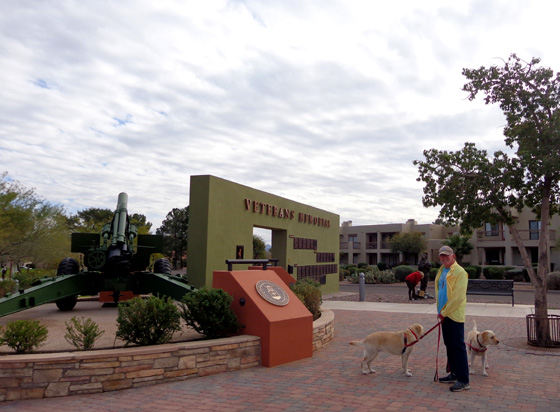
Jim and the girls wait for me as we approach the
Veterans' Memorial at Fountain Park.
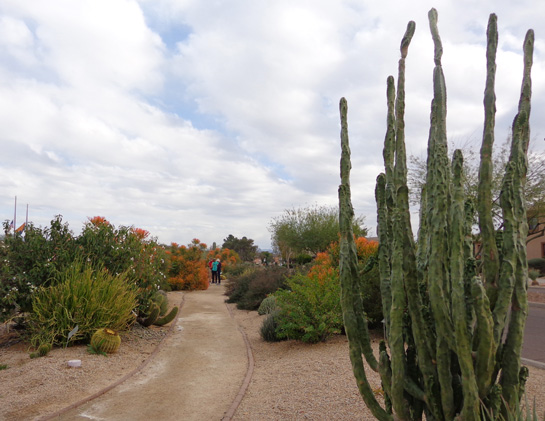
Handsome display of Sonoran Desert cacti
and other plants at Fountain Park
This is a beautiful park. If you're in the area, it's well worth a drive and a
walk to see the fountain, lake, landscaping, sculptures, and memorial.
It's easy to see why it's so popular with locals and visitors.
Here's a link to the
official park website, which
lists other things you can enjoy seeing and doing there.
DESERT VISTA DOG PARK
This three-acre City of Fountain Hills facility is one of the largest fenced dog
parks we've seen in all of our travels. We didn't find it until our last full
day here this week; we went back several more times in January.
Most of the acreage is designed for larger dogs to run around. There is a separate
area for small dogs but we saw some of them in the large-dog section.
Casey and Holly loved chasing balls we "chucked" to them. We haven't had very
many convenient or safe places to play ball with them this trip, so they had a blast.
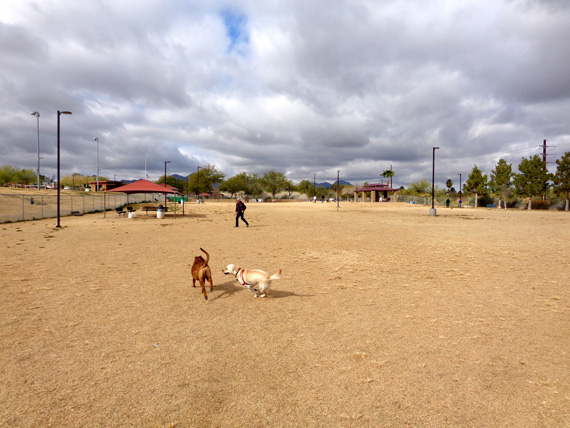
Holly is playing with a brown dog about her
size. The dog park is huge;
this picture doesn't even show all of it.
(12-26-18)
In addition to tons of room for dogs to run
around, there are at least two canopies on concrete pads with chairs for people to
sit out of the sun on hot days. Water and dog bowls are provided in several places.
We didn't see any dog poop lying around;people keep it clean.
This
park has some other amenities, too -- picnic
pavilions/shelters, skate park, walking track, and soccer fields.
If you want more information about McDowell Mountain Regional Park, here's the
official website.
Next entry: Jim successfully completes another 100-mile walk in 48 hours,
this time at Across the Years (ATY)
Happy trails,
Sue
"Runtrails & Company" - Sue Norwood, Jim O'Neil,
Cody, Casey, and Holly-pup
Previous
Next
© 2018 Sue Norwood and Jim O'Neil
